Intel Mobile Penryn Benchmarked: Battery Life Improves Again
by Anand Lal Shimpi on January 7, 2008 12:00 AM EST- Posted in
- CPUs
Mobile Penryn vs. Merom: Performance
What about raw performance? MobileMark 2007 does measure performance during the course of running the Productivity 2007 suite:
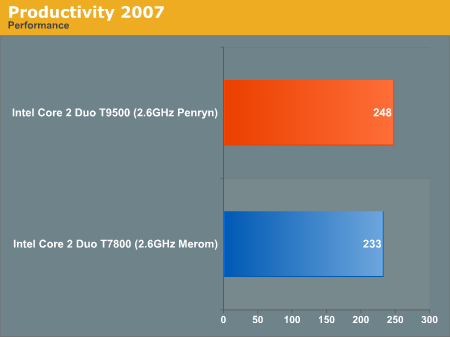
With a 6.4% increase in performance, the mobile Penryn saw a 16% increase in battery life. Remember that when you’re talking about running on battery power, being able to complete tasks faster can mean better overall battery life. The quicker a system can finish its work and move down to an idle state, the better.
Looking at our usual metrics, the Penryn based Core 2 Duo T9500 is still marginally faster than its Merom based predecessor across the board. SYSMark 2007 shows an overall increase of around 4.5%, with individual benchmarks showing an improvement in the 1 - 8% range.
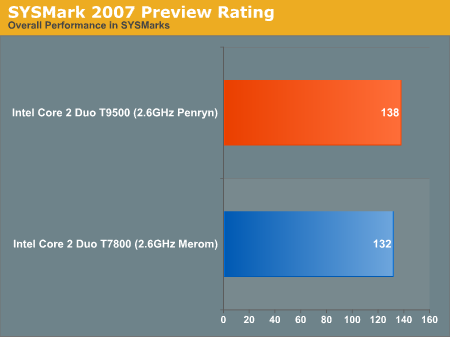
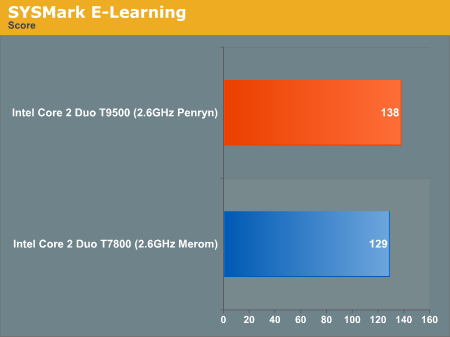
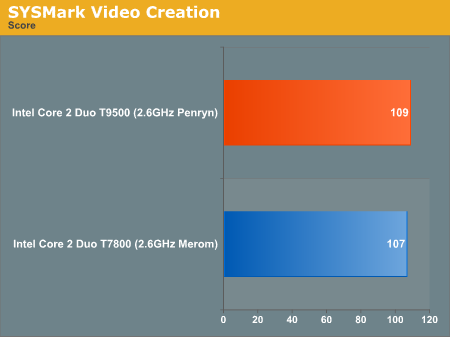

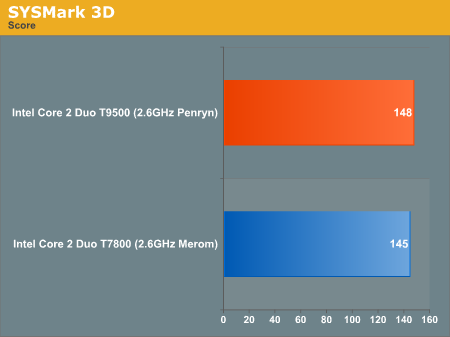
Media encoding performance is slightly better on the T9500, with our DivX and x264 tests completing 4.7% and 2.8% faster, respectively. Again, we don’t see an earth shattering improvement, but when you keep in mind that we can even talk about a performance improvement in the same breath as an improvement in battery life, we can’t really complain.
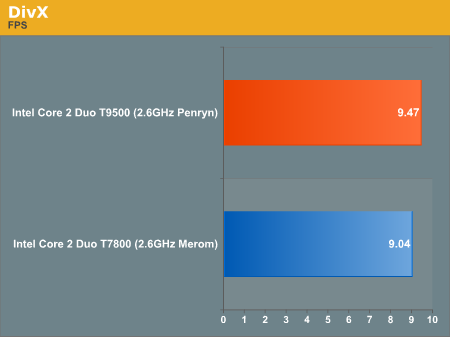
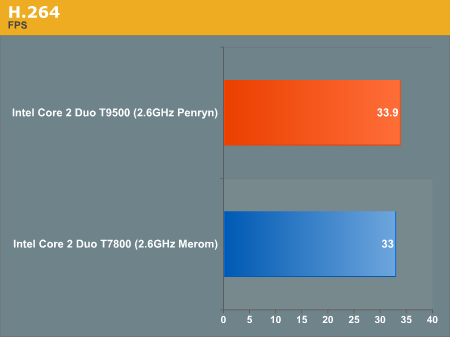
We ran a quick spotcheck on 3D rendering performance using Cinebench R10:
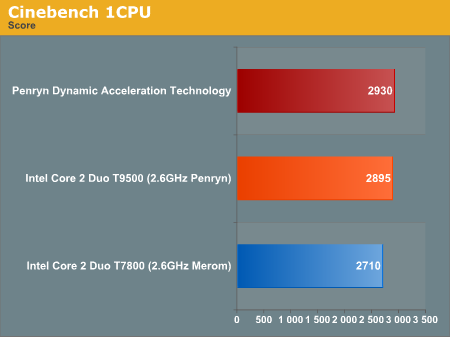

The single core tests show Penryn with a 6.8% performance advantage, while the multi-threaded benchmark grows that to 9.1%. Since Penryn has a 50% larger L2 cache, sharing data between the cores becomes a little easier and thus we see a small boost in the multi-threaded scaling factor.
Gaming benchmarks were out of the question given that our D630s shipped with Intel integrated graphics, but even armed with discrete graphics we’d expect Penryn to just slightly edge out Merom.
Testing Intel’s Dynamic Acceleration Technology
When Penryn was announced Intel promised a feature that sounded kind of interesting. The idea was that when running single threaded applications, a mobile Penryn would use the extra thermal headroom created by having a completely idle second core and increase the clock speed of the working core.
The performance boost would amount to nothing more than a single speedgrade (2.8GHz on our 2.6GHz chip), but the impact would be that you wouldn’t sacrifice any single threaded performance even on a multi-core CPU. One of the tradeoffs of building a dual-core CPU over a single-core is that you can’t generally hit clock frequencies that are as high, this technology gets around that.
We were skeptical about how the technology would work when we first heard about it. OSes like Windows Vista bounce threads from one core to the next, so a single core is never allowed to be completely idle for too long. Regardless, we wanted to try Intel’s “Dynamic Acceleration Technology” to see if: 1) we could get it to work and 2) if it made a difference.
Just as we suspected, getting it to work even while running a single threaded application was virtually impossible. We used CPU-Z to monitor clock speed while running single threaded applications, and our clock frequency never jumped above 2.6GHz. It wasn’t until we forced the processor affinity of an application to a single CPU core that we could actually see Intel’s DAT in action.
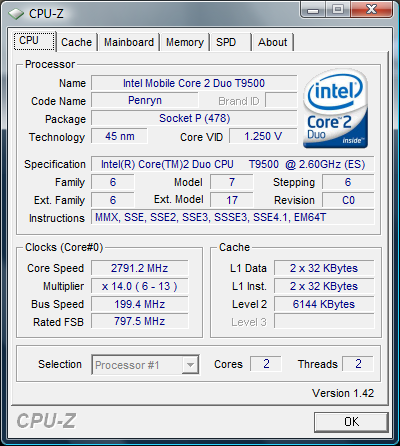
Even when enabled however, the impact was far less dramatic than you’d think. The working core will only increase its operating frequency as long as it has the thermal headroom to do so, which at times may only be for a matter of a second or two. When running the single-threaded Cinebench test our T9500 would increase its clock speed to 2.8GHz but only for very short periods of time. The result was a 2.6GHz CPU that every now and then ran at 2.8GHz, and the increase in performance reflected this.
With a 1.2% increase in performance due to Intel’s DAT, we can’t really get excited about this technology. It’s very rare that it will be working, and when it is the 7.7% increase in clock speed just isn’t enough to increase performance significantly at all. It looks like Intel’s DAT is more of a gimmick rather than something to get excited about.










18 Comments
View All Comments
sprockkets - Monday, January 7, 2008 - link
Looking for cheap 45nm desktop CPUs.I was going to build Intel for my latest customer, but at current prices of the 2.1ghz X2 vs. 1.6ghz Pentiums, AMD won again for being at least $35 cheaper.
eye smite - Monday, January 7, 2008 - link
It's interesting to see what intel does, but I'll stick with my turion laptop from 2k5.deeman - Monday, January 7, 2008 - link
I think Intel has moved Cantiga forward a bit from Feb/March to 2nd quarter, but not too far for me to think now is the time to upgrade only the CPU and retain the current Santa Rosa chipset.I am happy with my current battery life, but think a huge improvement will come in another quarter when Cantiga / Penryn / and a few other improvements like LED backlit screens, become more available and rolled together. With the chipset change, I am hoping for a much more significant change when largely idle (such as editing) along with the other benefits Cantiga should bring.
My thoughts would be to hold off, but am interested in other opinions on what Cantiga will bring to overall battery life.
somedude1234 - Monday, January 7, 2008 - link
These new mobile penryn's seem like the ideal candidates for an ultra-low power HTPC that still has enough power to handle the tough encoding jobs.Does anyone know if any of the motherboard vendors are planning on releasing desktop boards for these new chips?
bugs1109 - Tuesday, January 8, 2008 - link
I think AOpen will release a motherboard that will use this penryn mobile processor. They currently have desktop motherboards that takes mobile cpu.Chris Peredun - Monday, January 7, 2008 - link
I hate to be "That Guy" but I'm pretty sure you mean "Battery Life" not "Battery Live."Unless it's a description of the PR walloping that Microsoft is taking over the Xbox Live outage. ;)
Wesley Fink - Monday, January 7, 2008 - link
Thanks for the catch. The Title is corrected, but it wil not update until the next refresh, so please be patient for a few minutes.Cygni - Monday, January 7, 2008 - link
Just a heads-up, charts on page 4 are borked. ;)